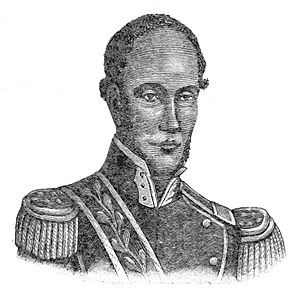Charles Rivière-Hérard facts for kids
Quick facts for kids
Charles Rivière-Hérard
|
|
|---|---|
 |
|
| 3rd President of Haiti | |
| In office 4 April 1843 – 3 May 1844 |
|
| Preceded by | Jean-Pierre Boyer |
| Succeeded by | Philippe Guerrier |
| Personal details | |
| Born | 16 February 1789 Port-Salut, Saint-Domingue |
| Died | 31 August 1850 (aged 61) Kingston, British Jamaica |
| Nationality | Haitian |
| Profession | Military (divisional general) |
Charles Rivière-Hérard (born February 16, 1789 – died August 31, 1850) was an important military leader in Haiti. He served as an officer in the Haitian Army under Alexandre Pétion. He became the third President of Haiti on April 4, 1843. However, he was forced to leave his position by a group of revolutionaries on May 3, 1844.
Contents
Early Life and Military Career
Charles Rivière-Hérard was born in Port-Salut, Haiti, on February 16, 1789. Not much is known about his early life. We do know that he fought alongside other revolutionaries against the French. He was an officer who led a group of Black soldiers later in his military career.
Becoming President
Hérard was a main leader in the group that removed President Jean-Pierre Boyer from power. This happened during the 1843 Revolution. On December 30, 1843, a new Constitution was created for Haiti. General Hérard had the loyalty of the army. Soon after, he took control of the government. He then declared himself President of Haiti.
Conflict with the Dominican Republic
Soon after Hérard became president, the eastern part of Haiti revolted. This area is now known as the Dominican Republic. On February 27, 1844, rebels took over the capital city of Santo Domingo. The next day, they declared their independence from Haiti.
Hérard quickly responded to this. In March 1844, two Haitian armies invaded the new Dominican Republic. One army, led by Hérard, had over 10,000 soldiers. They arrived at Azua. There, about 3,000 Dominican soldiers were waiting. The battle began on March 19. The Dominicans won, with very few losses. More than 1,000 Haitian soldiers died.
The other Haitian army was in the north. It was led by General Pierrot. On March 30, this army appeared near the city of Santiago de los Caballeros. The Haitians were also defeated there. About 600 Haitian soldiers died. The Dominicans had only one soldier injured. This army left the battle area the next day. They faced more attacks as they retreated.
The Haitian army at Azua could not get through the mountains. They also kept losing soldiers. So, they retreated back to Port-au-Prince. Before leaving Azua, they burned many houses. In return, Dominican ships attacked Haitian cities along the coast.
Facing Opposition
Hérard faced growing problems within his government. The political situation in Haiti was getting worse quickly. On March 30, 1844, Hérard decided to cancel the new Constitution and close the Parliament.
During Hérard's invasion of the Dominican Republic, a new revolt started in Haiti. By the end of March 1844, an army of farmers and peasants gathered. They were near the city of Les Cayes in the southwest. These rebels were called piquets. This name came from the long pikes (spears) they carried. They were led by General Jean-Jacques Acaau. Their group was known as "L’Armée Souffrante," which means the "Army of the Sufferers." In April, they defeated a government army. However, their advance toward the capital was stopped at the town of Aquin.
End of Presidency
The problems did not stop for Hérard. While General Acaau was marching from the south, another revolt started in the North. This revolt was supported by Hérard's opponents in the government. Facing these big challenges, Hérard gave up his presidency on May 3, 1844. He went into exile on June 2, 1844. He moved to Jamaica, where he passed away on August 31, 1850.
See also
 In Spanish: Charles Rivière-Hérard para niños
In Spanish: Charles Rivière-Hérard para niños

